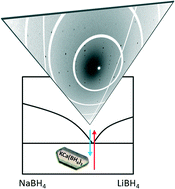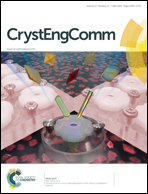Flux-assisted single crystal growth and heteroepitaxy of perovskite-type mixed-metal borohydrides†
Abstract
Structural investigations on mixed-metal borohydrides have been the subject of powder diffraction since the discovery that hydrogen-release temperatures can be tailored by using more electronegative metals. The lack of producing suitable samples for single crystal X-ray diffraction has defined powder diffraction as the method of choice which, however, is less sensitive to the structural details of the compounds in question. Here we show how to overcome this limitation by developing a flux-assisted single crystal growth procedure to lower the melting point of mixed-metal compounds that are thermally unstable and usually decompose before melting, or are unstable in the melt. We prove the validity of this principle on a member of the recently reported perovskite-type class of borohydrides and show that the defined approach is easily generalized. Interesting structural details are revealed that stand in contrast to the results obtained from samples produced by mechano-chemistry. The differences in lattice instabilities are discussed and put into context with the discovered epitaxial relationships between rocksalt-type ABH4 and perovskite-type ACa(BH4)3 (A = alkaline metal). In this context, the preliminary results provide a valuable scheme that can be made use of when physical deposition of metal borohydrides reaches its working stage.


 Please wait while we load your content...
Please wait while we load your content...